
The Solar-Terrestrial Centre of Excellence (STCE) is a collaborative network of the Belgian Institute for Space Aeronomy, the Royal Observatory of Belgium and the Royal Meteorological Institute of Belgium.
 |
Published by the STCE - this issue : 21 Aug 2014. The Solar-Terrestrial Centre of Excellence (STCE) is a collaborative network of the Belgian Institute for Space Aeronomy, the Royal Observatory of Belgium and the Royal Meteorological Institute of Belgium. |
| Archive of the newsletters | Subscribe to this newsletter by mail |
The seventh Solar Information Processing workshop (SIP7) is currently ongoing in La Roche-en-Ardenne, Belgium. About 80 solar and space scientists, statisticians, and data processing experts from all over the world have convened this week to discuss the challenges of optimizing the science return of solar and heliospheric missions and to address the data analysis issues of these missions.
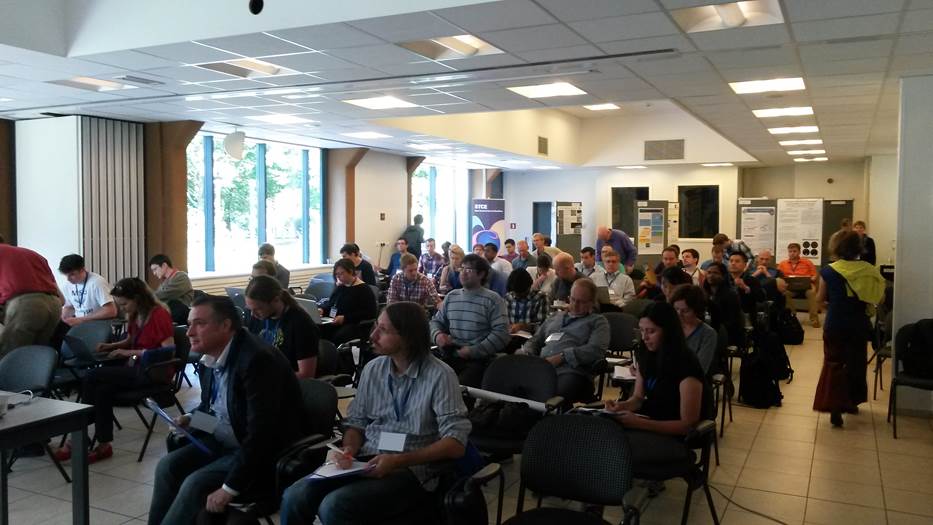
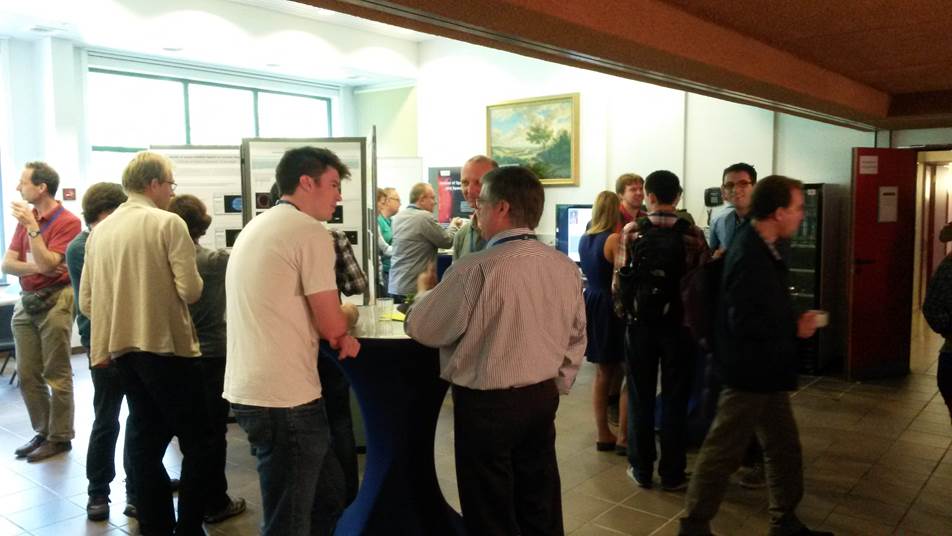
Though the workshop is still ongoing, above pictures provide already an idea of the meeting's atmosphere. It also seemed fit to the goal of this meeting -finding more information from existing data- to provide a word search with some terminology often used by the experts. These words are hidden in an apparent random grid of letters. They can be from left to right, top to bottom, diagonal, reverse, and they can even have letters in common. The purpose of the puzzle is to find all the words. Happy processing!
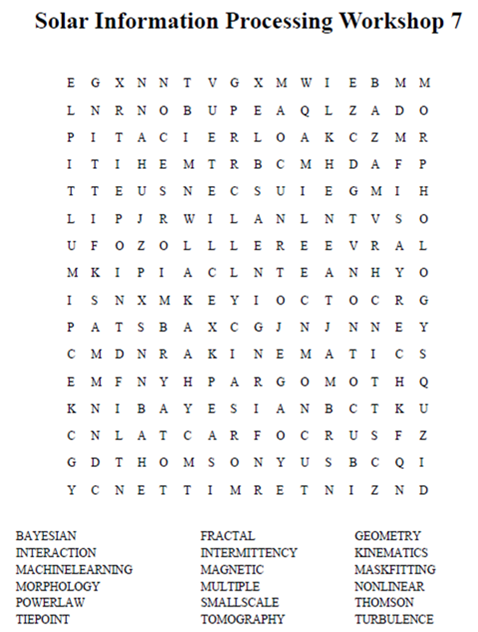
The level of solar activity was between very low and low this week.
In order to view the activity of this week in more detail, we suggest to go to the following website from which all the daily (normal and difference) movies can be accessed: http://proba2.oma.be/ssa
This page also lists the recorded flaring events.
A weekly overview movie can be found here: http://proba2.oma.be/swap/data/mpg/movies/WeeklyReportMovies/WR229_Aug11_Aug_17/weekly_movie_2014_08_11.mp4 (SWAP week 229).
Details about some of this week’s events, can be found further below.
Early morning, a prominence eruption occurred on the North limb. This event can be nicely seen in the weekly overview movie above.
In addition an eruption occurred on the East limb during the evening:
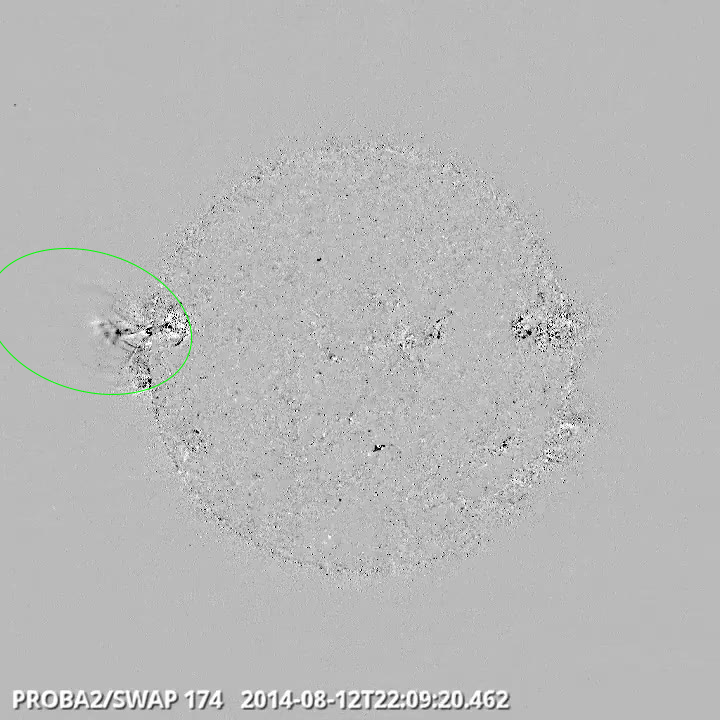
During the evening, a prominence located in the south west quadrant erupted, generating a solar arcade.
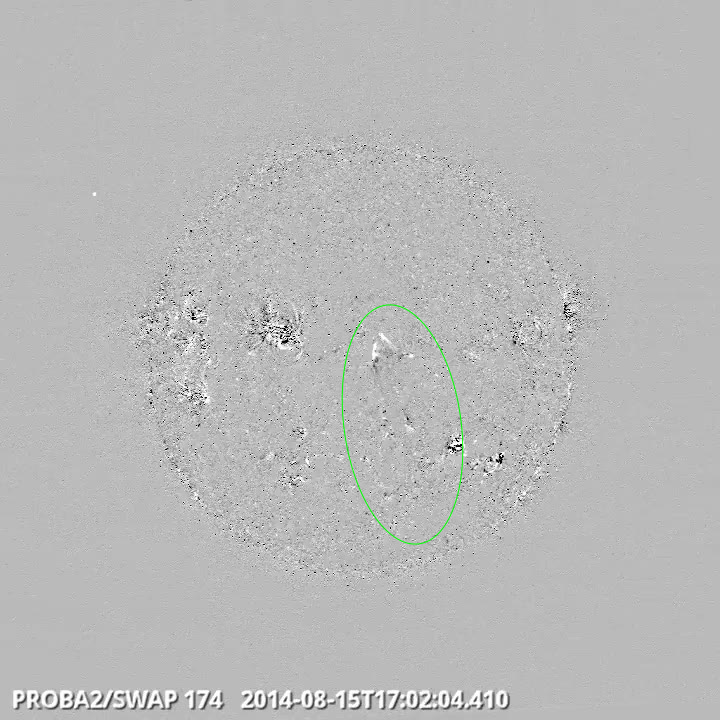
A small eruption occurred in the South West quadrant, generating a nice plasma flow along the magnetic field lines of AR12144.
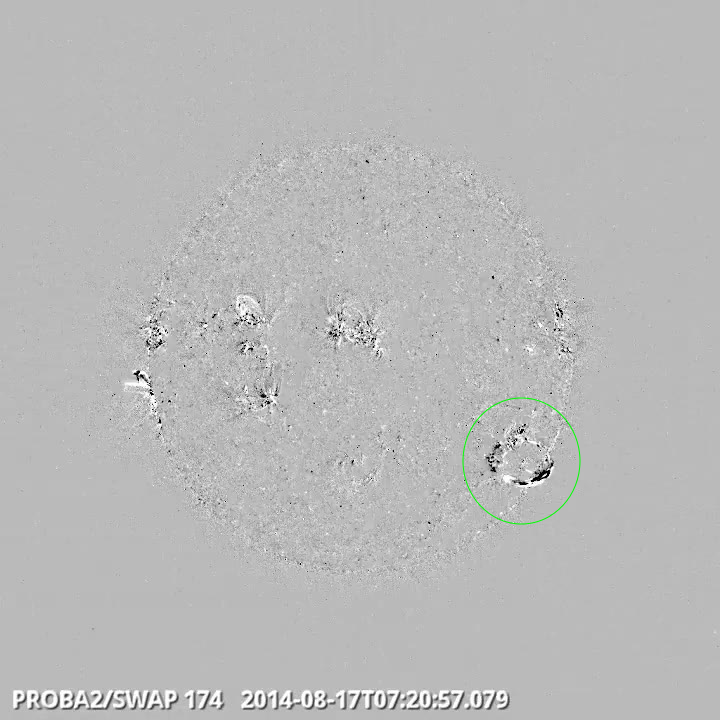
Solar activity was mostly at B level during the week of August 11 to 17, 2014. In total, eight C flares were observed, produced by NOAA regions 2139, 2144, 2132 and 2146.
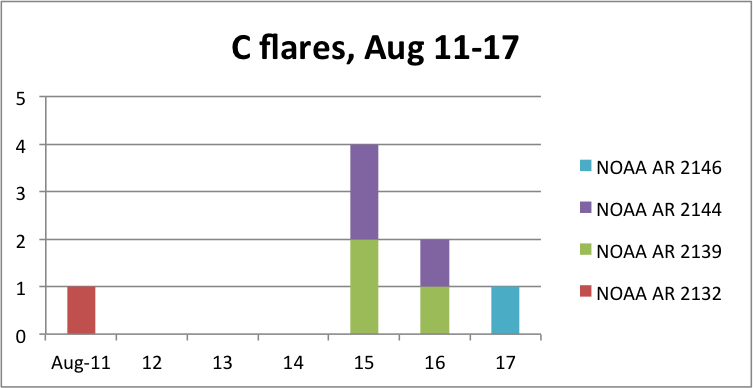
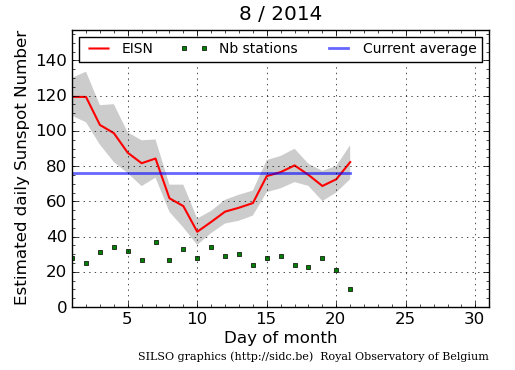
Solar wind speed as observed by ACE increased from about 400 to 500 km/s on August 11 and 12, probably due to the arrival of a coronal hole high speed stream. The magnitude of the Interplanetary Magnetic Field (IMF) at that time varied between about 6 and 12 nT. Afterwards, solar wind speed gradually decreased to about 300 km/s on August 17. The magnitude of the IMF ranged between 2 and 4 nT between August 13 and August 17, and reached values above 8 nT on August 17. Check the graphs.
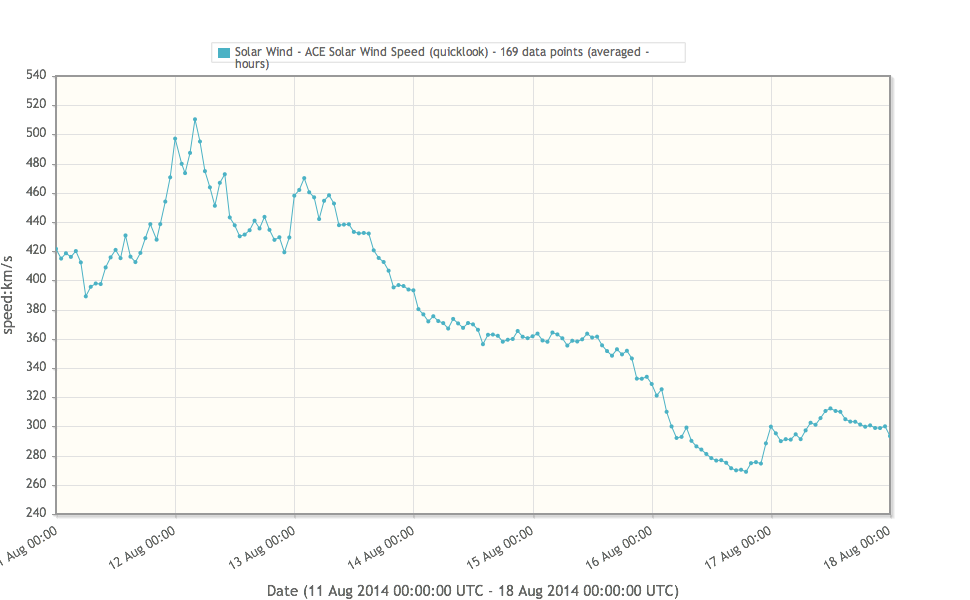
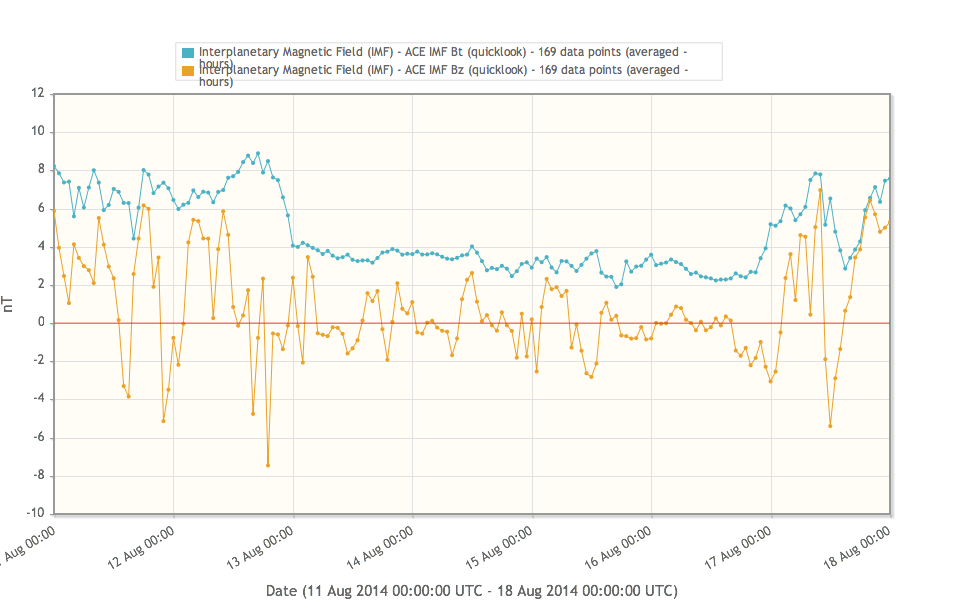
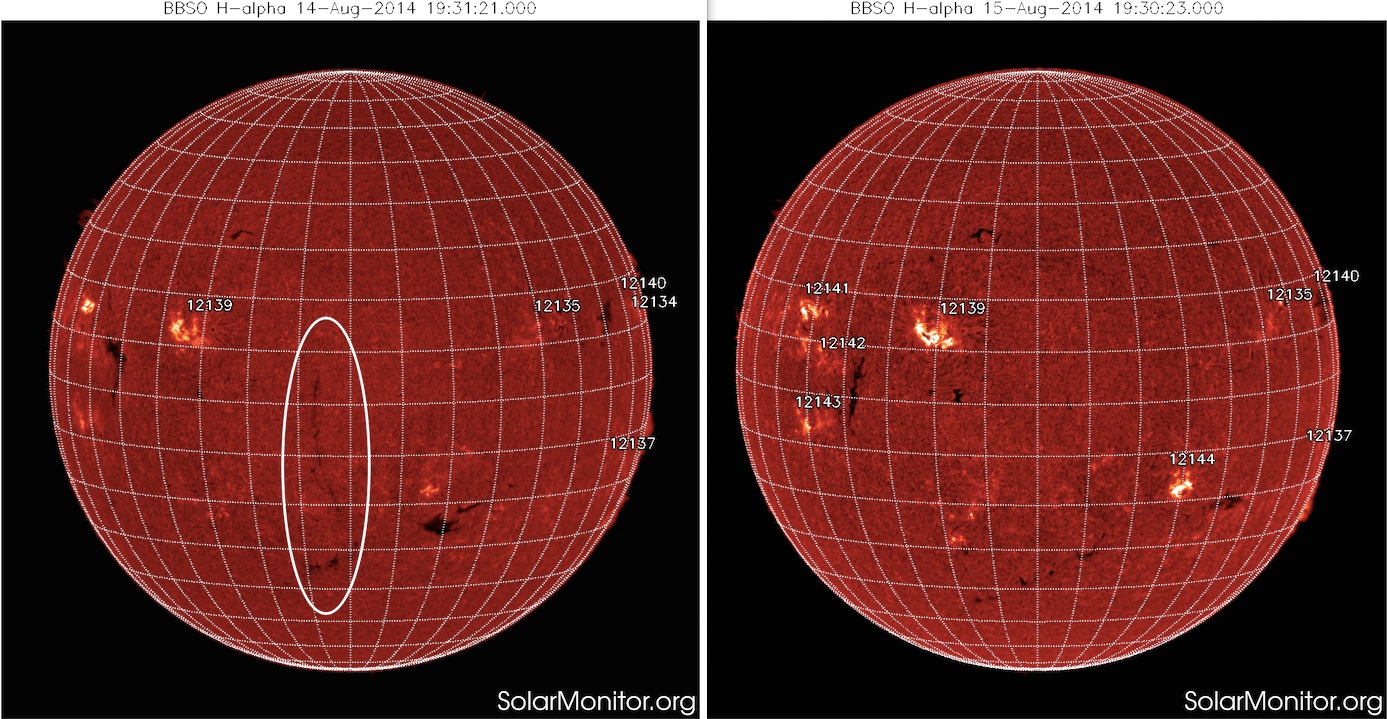
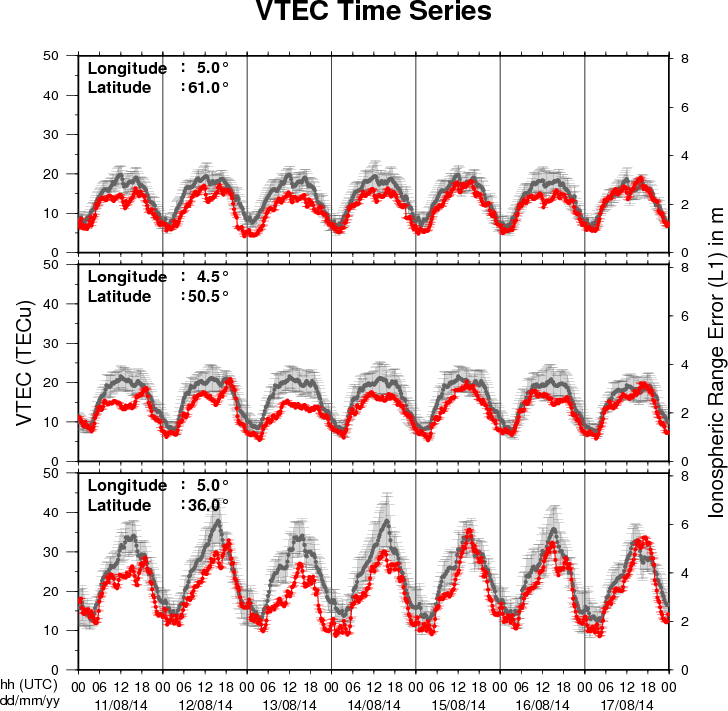
The VTEC is expressed in TECu (with TECu=10^16 electrons per square meter) and is directly related to the signal propagation delay due to the ionosphere (in figure: delay on GPS L1 frequency).
The Sun's radiation ionizes the Earth's upper atmosphere, the ionosphere, located from about 60km to 1000km above the Earth's surface.The ionization process in the ionosphere produces ions and free electrons. These electrons perturb the propagation of the GNSS (Global Navigation Satellite System) signals by inducing a so-called ionospheric delay.
See http://stce.be/newsletter/GNSS_final.pdf for some more explanations ; for detailed information, see http://gnss.be/ionosphere_tutorial.php
Start : 2014-09-07 - End : 2014-09-12
Planetary space weather can be characterised by changes in the
ambient planetary magnetic field and plasma populations around the
planetary environment while space climate refers to the long-term
changes in space weather conditions. Space weather and space
climate are driven by the changes in the Sun. The effects of Space
Weather on the Earth's environment are well documented,
particularly in terms of risk to satellites, communications and
ground-based systems such as electrical power grids and pipelines.
However, planetary space weather and space climate studies as well
as better prediction models for space weather are needed. Typically
differences in the magnetic field and plasma environment at
different planets, as well as the distance of the planet from the
sun drives different space weather effects as we move through the
solar system. The use of solar wind propagation models combined
with solar observations allows us to obtain and predict the
interplanetary conditions around each planet.
We solicit papers on planetary as well as terrestrial space
weather and space climate, where data from past and on-going space
missions such as ACE, SOHO, SDO, MEX, VEX, MESSENGER and CASSINI is
used. We welcome papers on observations as well as modeling of
space weather and space climate in our solar system.
Website:
http://meetingorganizer.copernicus.org/EPSC2014/session/16809
Start : 2014-09-09 - End : 2014-09-11
The Workshop on Radiation Monitoring for the International Space
Station (WRMISS) has been held annually since 1996. The major
purpose of WRMISS is to provide a forum for discussion of technical
issues concerning radiation dosimetry aboard the International
Space Station and other spacecraft. This includes discussion of new
results, improved instrumentation, detector calibration, and
radiation environment and transport models. The goal of WRMISS is
to enhance international efforts to provide the best information on
the space radiation environment in low-Earth orbit and on the
exposure of astronauts and cosmonauts in order to optimize the
radiation safety of space crew.
Website:
http://www.ifj.edu.pl/conf/wrmiss/
Start : 2014-09-15 - End : 2014-09-20
The 'Geospace Revisited' conference aims at revisiting
long-standing issues of geospace dynamic phenomena. New data from
space missions like Cluster, THEMIS and the more recent Van Allen
Probes, along with measurements from ground-based magnetometer
arrays around the globe, processed with new methods and combined
with theory and simulations are expected to shed light on the
complex interplay of particles, fields and waves in geospace, and
in particular the inner magnetosphere (radiation belts and ring
current).
Website:
http://geospacerev.space.noa.gr/index.php
Start : 2014-11-12
This conference aims to bring together researchers, engineers,
users in the area of Big Data in the Space sector.
The focus is on the whole data lifecycle, ranging from data
acquisition by spaceborne and ground-based sensors to data
management, analysis and exploitation in the domains of Earth
Observation, Space Science, Space Engineering, Space Weather,
etc.
Special emphasis will be put on highlighting synergies and
cross-fertilization opportunities from domains like Climate Change,
Solid Earth Science, Planetary Sciences, Life Science,
Astrophysics, High Energy Physics, Social Sciences, etc.
We expect this conference to:
* contribute towards a common "Big Data from Space" scientific
and programmatic framework
* widen competences and expertise of universities, labs and
industrial actors
* foster networking of experts and users towards better access
and sharing of data, tools and resources
* leverage innovation, spin-in, spin off of technologies, and
business development arising from research and industry
progress
Website:
http://congrexprojects.com/2014-events/BigDatafromSpace/objectives
Start : 2014-11-17 - End : 2014-11-21
The 11th Edition of the European Space Weather Week will take
place on 17-21nd November 2014 in Liège, Belgium.
The ESWW will again adopt the central aim of bringing together
the diverse groups in Europe working on different aspects of Space
Weather. This includes but isn't limited to the scientific
community, the engineering community, applications developers,
service providers and service end users.
The meeting organisation is coordinated by the Belgian
Solar-Terrestrial Centre of Excellence (STCE), ESA and the Space
Weather Working Team. The local organisation is done by the
STCE.
Website:
http://www.stce.be/esww11/
Start : 2014-12-15 - End : 2014-12-19
The AGU Fall Meeting is the largest worldwide conference in the
geophysical sciences, attracting more than 22,000 Earth and space
scientists, educators, students, and other leaders. For 46 years,
energized and passionate Earth and space scientists from around the
world gather at the AGU Fall Meeting to connect with colleagues,
broaden their knowledge base, and embrace the joy of science. The
2014 meeting takes place Monday 15 - Friday 19 December 2014.
Several sessions about space weather are foreseen:
*
When and Why Does Space weather Forecasting Fail?
*
Addressing Operational Space Weather Needs
*
Near Real Time Data for Earth Science and Space Weather
Applications
*
Understanding Hemispheric Asymmetry and Space Weather
*
Connection of Solar Events With the Variability of Space
Environments
*
Bz from the Sun to the Earth: Observations and Modeling
*
Solar Sources and Heliospheric Consequences of Coronal Mass
Ejections in Solar Cycle 24
*
Advances in Ionospheric Forecasting - Modeling, Observations, and
Validation
Abstract Submission Deadline: August 6, 2014
Website:
http://fallmeeting.agu.org/2014/
Start : 2015-04-20 - End : 2015-04-24
This gathering was born out of the desire to collect in one
place the latest technologies required for advancement of science
in the discipline of Solar and Space Physics. In doing so, it was
recognized that the two 1998 volumes of 'Measurement Techniques in
Space Plasmas' (Particles and Fields) have been a valuable
reference and resource for advanced students and scientists who
wish to know the fundamentals of measurement techniques and
technology.
Website:
https://mtssp.msfc.nasa.gov/
Start : 2015-06-22 - End : 2015-07-02
We invite contributions on novel inversion methods with
application across the geosciences. Of particular interest are 3D
imaging, joint inversion of geodetic, geophysical and geochemical
datasets, and multi-disciplinary interpretation approaches such as
integration of gravity, EM and seismic data or thermo-mechanical
modelling studies constrained by physical parameters.
Modelling of Space Weather Effects: Solar, Magnetospheric and
Earth Resistivity Constraints (IAGA, IAMAS)
In this symposium we welcome contributions on all aspects of the
modelling of space weather and its effects, from the Sun to Earth.
This includes the modelling of the various interactions between
travelling solar storms and the solar wind, magnetosphere,
ionosphere and solid Earth and the validation of models through
measurements. Contributions on models developed to aid end-users,
such as satellite and power grid operators, survive the impact of
space weather are also encouraged.
Website:
http://www.iugg2015prague.com/joint-inter-association-symposia.htm#JA